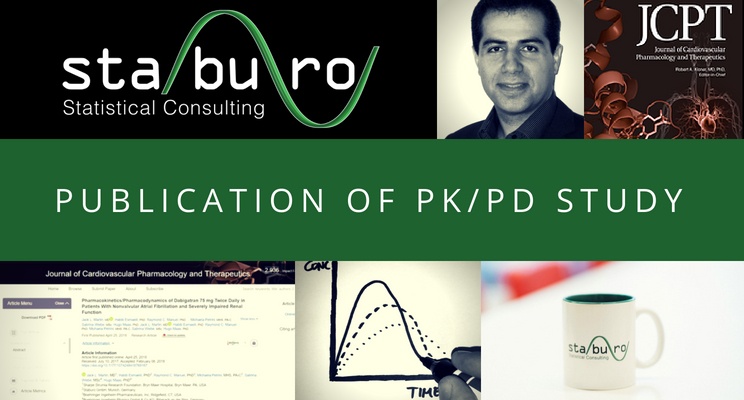
Staburo contributed to publication in the Journal of Cardiovascular Pharmacology and Therapeutics
Staburo could show, once again, its state-of-the-art biostatistics expertise, by supporting this scientific publication. Here, you find a short summary about the study.
Summary
Dabigatran etexilate is an oral direct thrombin inhibitor. Dabigatran excretion is 80% renal, so exposure increases
with severity of renal failure, which can lead to more adverse events (AE). The FDA approved dabigatran etexilate 75 mg twice daily (BID) for patients with nonvalvular atrial fibrillation (NVAF) having severely impaired renal function (creatinine clearance: 15-30 mL/min), based on post-hoc pharmacokinetic modeling and not based on results of a clinical trial for this population. In this trial, we assessed dabigatran exposure at trough and peak levels in patients with NVAF and severely impaired renal function and compared the result with predictions from PK model.
Methods
Patients received dabigatran etexilate (75 mg BID) for 7 days before blood sampling; Steady-state pre-dose concentration (trough) and steady-state peak concentration were taken. Pharmacodynamic parameters at baseline were assessed by established coagulation assays.
Results
Of 60 treated patient, 40% were male and 78.3% were white; median age was 84 years. Steady-state pre-dose concentration values were close to pharmacokinetic modeling predictions with a geometric mean (gMean) of 155 ng/mL, geometric coefficient of variation (gCV) of 76.9%, and range of 15.6 to 498 ng/mL. The Steady-state post-dose peak had a gMean of 202 ng/mL, gCV of 70.6%, and range of 42.0 to 680 ng/mL. Pharmacodynamic effects on coagulation paralleled dabigatran concentrations. Eleven (18.3%) patients had at least one AE; pharmacokinetic results for these patients versus those without AE showed higher trough and peak values. All bleeding events were considered minor by the investigators.
Conclusion
Dabigatran exposure levels largely confirmed earlier pharmacokinetic predictions, supporting the use of dabigatran etexilate 75 mg BID in patients with NVAF and severely impaired renal function. Pharmacodynamic results were also in agreement with earlier studies.

Recent Comments